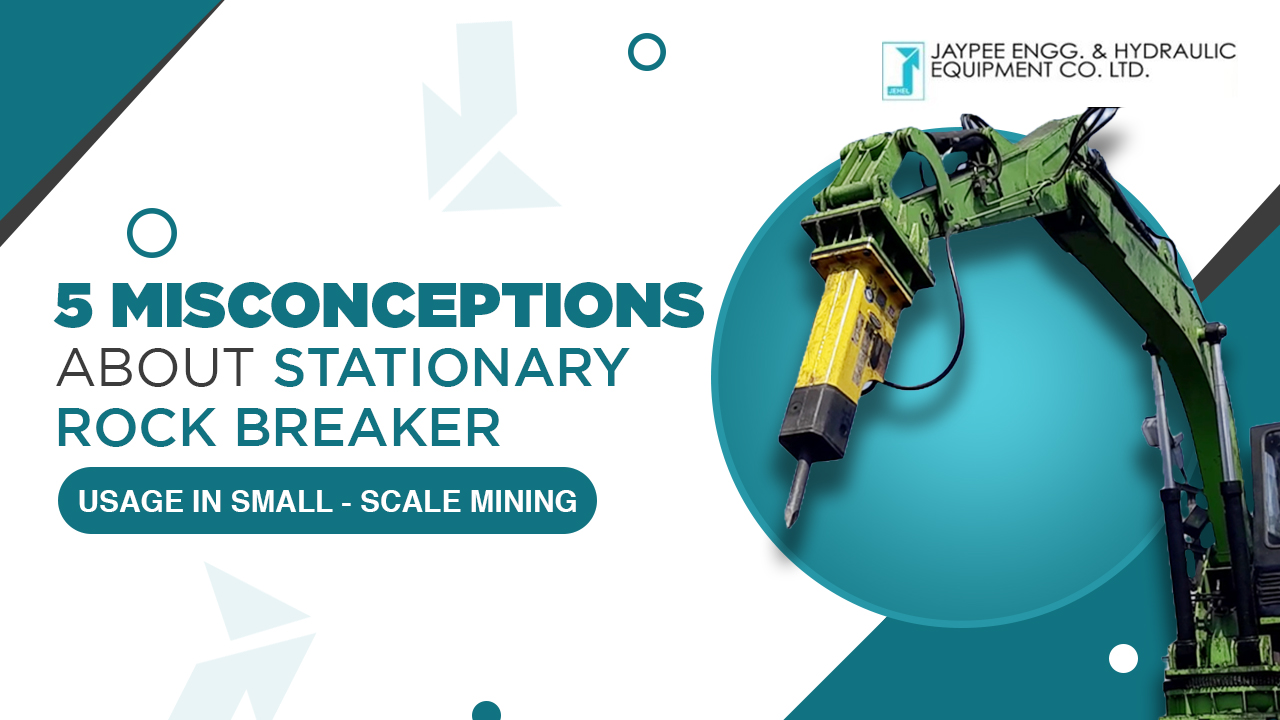Stationary rock breakers are too expensive for small-scale mining. 70% of small mine operators think this. However, the startling reality is that human rock-breaking techniques and machine failures cost small mining enterprises up to $50,000 a year. In the meantime, astute operators who employ JEHEL’s stationary rock breakers get a return on their investment in as little as 8 to 12 months thanks to higher output and lower operating expenses.
Many antiquated ideas in the mining sector cost companies money. We’re dispelling the top five myths regarding the use of stationary rock breakers in small-scale mining today. Now is the time to distinguish reality from fiction and learn why JEHEL’s cutting-edge hydraulic pedestal rock crusher systems are ideal for businesses of all sizes.
1. “Stationary Rock Breakers Are Only For Large Mines”
It is a general perception among small mining operations that rock breakers are suited only for large-scale mining. In reality, Jehel offers compact sizes that are tailored for local and small-scale operation, discrediting this belief. Power shovels, electric mining shovels, and other small-scale mining equipment operate without any hassles.
These modules operate for small coal, limestone, and iron ore mines. It is incorrect that only big operations stand to gain. There is no necessity to presume only for ease that they are too expensive or difficult to maintain; the same technology applied in large quarries can, and does, apply to small miners. Further, this translates to increased productivity without a huge equipment investment or space upgrade.
2. “They Are Too Expensive or Hard to Maintain”
A fallacy that comes into play is that the machines have very high operating expenses. But Jehel’s stationary rock breaker reduces costs in the long term. Blockage prevention techniques based on accurate hydraulic power systems are fitted on crushers.
As a result, the unjamming of crushers results in lower downtime. Wear of parts decreases, leading to lower maintenance and repair bills. With locally produced hydraulic cylinders and assembly, Jehel enhances the durability of the system by using high-strength steel. The machines save long-term costs by reducing maintenance and repair.
3. “They Are Unsafe and Cause Flying Debris”
Some small-scale miners have feared automatic breakers because rock fragments are at risk of flying in unpredictable directions. Jehel’s stationary rock breaker emphasizes safety by concentrating on particular rock fragmentation. Each unit is mounted on a pedestal or articulating boom crane that enables it to travel to target oversized boulders and break them under control.
Smooth movement and low vibration are achieved using hydraulic controls, with minimal noise being produced, and reduced risk exposure when operating breakers improves operator efficiency. Site safety increases as the danger of stray rock debris is eliminated and more effectively controlled by the design.
4. “They Cannot Operate Within Simple Systems”
Jehel’s fixed rock breakers are made to complement each other easily in operational configurations. The idea that these systems need big cranes or an elaborate setup is untrue. Jehel’s rock breakers rotate up to 360 degrees around a hopper or grizzly. They can be placed alongside the main crusher inlets or wagon tippler hoppers.
Even in small sizes, Jehel’s models are designed to accommodate various sizes of hoppers. Consequently, with minimal reorganization, even small mining yards can incorporate this technology. Any feeders, crushers, and conveyors already in place are all integrated into the system. Instead of needing an entire system replacement, it fits in elegantly.
5. “They Only Work Remotely or Require Extensive Training”
Advanced technical knowledge or remote control is said to be needed to operate rock crushers. Jehel offers systems rock breakers that are safe and simple to use. Although the fundamental characteristics are simple, more modern versions can be combined with sophisticated systems. The breaker is rotated, started, and stopped using control panels.
Complex setups or IT training are not required. Automation, uptime, and predictive maintenance are improved with the addition of innovative alert systems, remote control, or Internet of Things (IoT) monitoring. The fundamental system is friendlier and easier to use, particularly for smaller operations.
Conclusion
Stationary rock breakers provide immense value to small-scale mining operations. However, the perceived value exists due to the assumption that the machinery is designed for large mines, complex, or even costly. Compact, affordable, and robust in design, these machines are tailored to different hopper and grizzly configurations, debunking such myths.
Diesel-powered breakers from Jehel reduce downtime in jaw crushers, lower maintenance costs, and enhance operational safety at the site. Jehel stationary rock breakers seamlessly integrate into existing layouts and are simple to operate. Their hydraulic construction provides accurate operation, energy efficiency, and long operational life. These systems allow even small operators to capitalize on the advantages of big mining.
If you manage or lead a small mining operation, you need to take a second look at this design. Safety and ease of entry are hallmarks of Jehel’s stationary rock breakers. Jehel can assist you in choosing the best model for your mine. Allow Jehel to help you increase efficiency, reduce downtime, and increase productivity smoothly with rugged, proven technology tailored to your operational scale.


